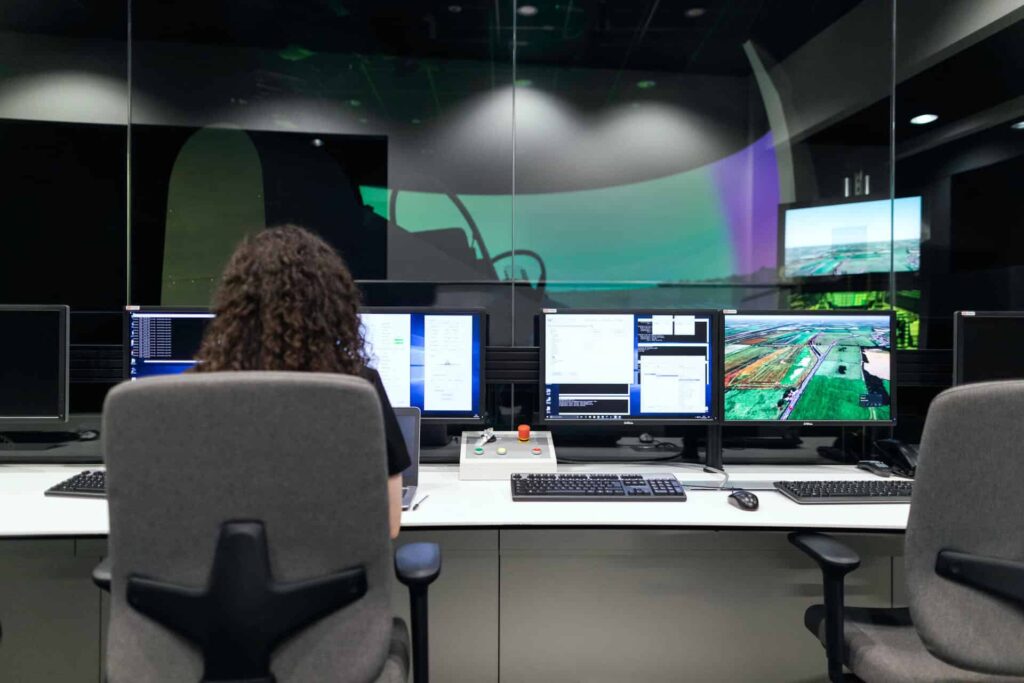Digital workplace solutions are the smart answer for companies looking to become more future-proof while also improving employee experience.
The workplace is changing, becoming increasingly flexible and hybrid. To succeed in this ‘new normal,’ companies are embracing the digital workplace to streamline efficiencies and increase productivity. This in turn can help position their organization as an attractive workplace. It can also help them manage increasing complexity and diverse challenges.
Of course, this can only happen when companies embrace the right technology in the right way. In this article, we explore the best digital workplace solutions and how to embrace them for a better office and happier workers.
What is a digital workplace?
Like the name suggests, a digital workplace is the new space where work takes place online and on devices.
The workplace has already used basic technology like emails and smartphones for decades. The digital workplace expands this digital realm with cloud-based collaboration and communication tools, virtual meetings, customer relationship management (CRM) software, and an assortment of other business applications that can be accessed online through a central workplace platform. It may also use workspace sensors and the Internet of Things.
The digital workplace can complement the physical office, making it particularly important for hybrid work.
It can also completely replace the physical office, assuming facility managers (FMs) are using the right tools with the right functionality to keep all workflows intact.
The reality is that people no longer have to sit at their physical desks to do their work.
In fact, given the proliferation of flexible seating and desk sharing, it’s typically best if employees don’t have their ‘own’ desktop, and instead sign into role-based accounts and services to work.
For these reasons, well-integrated digital tools are quickly becoming a necessity for today’s workplace.
Ideally, these digital tools will be on the cloud, and will focus on user experience.
Better still, they’ll also be available on a mobile app that people can access from anywhere.

What are digital workplace solutions?
Digital workplace solutions are all the tools that successfully power today’s digital workplace. For example, request management software and other systems, as well as email and other collaboration and communication tools.
The best digital workspace solutions will be cloud-based and user-friendly.
Otherwise, digital workplace solutions will look a little different for each company, preferably starting with a workplace platform and branching out into the tools most relevant to all stakeholders.
Ideally, these tools will be maintained by robust, overarching facility management software that streamlines disparate workplace services into one cohesive platform.
The digital workplace and employee experience
One of the driving forces behind adopting a more digital workplace is the desire to improve employee experience.
Employee engagement and satisfaction should always be a top priority. Staff that are happy and engaged are more productive and more likely to stick around.
Thanks to the pandemic, the majority of workers have now experienced some degree of flexibility with their working arrangement. This is often in the form of hybrid work. After getting this little taste, they don’t want to give it up.
Specifically, a recent Harris Poll commissioned by OfficeSpace found that the majority of workers want to maintain some degree of flexibility. In fact, a full 43% said they would quit their job if required to return to the office full time. This corresponds with studies that show flexible working can lead to more job satisfaction.
Digital workplace solutions can support these workers by giving them the tools to improve hybrid and remote working.
At the same time, surveys also show that employees forced out of the office by the pandemic have missed things like in-person and spending quality time with co-workers. Here, again, digital solutions can help improve employee experience, by making things like digital collaboration more rewarding.
For example, FMs can use better technology to run more effective hybrid meetings, helping to overcome the ever lurking Zoom fatigue.
Ultimately, the office is no longer the only place where employees work. An improved digital workspace will help improve their working experience from any location.
Combining the digital workplace and hybrid work
There is now universal consensus that hybrid is our ‘new normal’ and the future of work. We’re currently seeing four hybrid workplace models emerging, all of which can benefit from the digital workplace:
1. Traditionalist hybrid offices
In traditionalist hybrid offices, companies only roll out the bare minimum of hybrid work. This is often because most of their work can’t be done remotely. In these cases, it may be roles like HR or accounting that are off-site.
2. Architect hybrid offices
In this model, employees will be mostly remote but can book desks on request. FMs often implement this primarily to reduce real estate costs.
3. Nomad hybrid offices
In nomad offices, employee preferences help dictate how often they use the office. The office typically becomes more of a space for flexible work and collaboration. While companies are looking to reduce real estate, their focus is on improving the employee experience.
4. Pioneer hybrid offices
Pioneer hybrid offices offer the most freedom to workers, letting them pick when and where they work. They may even do away with the physical office altogether, moving squarely into the digital workplace.
No matter what model a company follows, if it uses any form of hybrid working, it will need well-integrated workplace solutions.
Specifically, workers who toggle between working from home and working from the office will need a seamless experience. This is best facilitated with the right software solutions. And remote workers will always need access to the exact same tools and level of technology as their in-office counterparts, which again demands cutting edge digital solutions.
Digital solutions for hybrid work can also enhance remote collaboration, so that disparate workers can easily connect, no matter their location.
Ultimately, it’s often digital workplace solutions that allow companies to adapt to new office environment types quickly and easily. And hybrid is no exception.

Why are new workplace trends emerging?
New workplace trends are emerging because employee needs and business requirements are rapidly changing. Also, because there are now better technology solutions available to meet them.
The workforce is aging, and as Boomers start to retire, they’re being replaced by younger generations in the workplace with very different expectations for how work should be organized and done.
Moreover, the COVID-19 pandemic has made it crystal clear that companies need to be able to adapt quickly to change. Change is much easier when they’re nimble and digitally savvy.
Like we’ve covered, the pandemic also accelerated a pivot towards hybrid work models and a more flexible workplace. As we return to the office, most workers don’t want to give up their newfound freedom.
Of course, the return to the office is coinciding with the Great Resignation, so that organizations are having to grapple with improving employee experience and employee engagement like never before.
Simply put, those who don’t embrace the digital workplace to improve employee satisfaction won’t be able to attract and keep top talent.
And as competition increases, employee productivity can make or break a company, further calling on an improved workplace experience.
These factors are all combining to create a demand for new and flexible ways of working. Flexible working can streamline business processes and provide employees and employers alike more flexibility.
Note, too, that one of the new digital tools available to companies is simply the ability to collect and analyze more relevant, real-time data about their business and workplace than ever before.
FMs can use this data to make more insightful decisions and more effectively test new digital workplace solutions. This is further fueling the push to embrace new workplace trends.
What new workplace trends are emerging?
Emerging new workplace trends are typically ones that help create a more user-friendly office and lead to happier and more productive workers.
Not surprisingly given post-pandemic employee sentiment, most new trends embrace some degree of flexibility. Beyond or instead of supporting a hybrid workforce, companies are embracing many other new working styles, as well.
For example, activity-based working is becoming increasingly popular due to its positive effect on both productivity and employee engagement. In this way of working, employees are able to let what they’re doing decide where they do it. They can work in a collaborative space for most of one day, for example, but find a phone booth when they need to make a private call.
Similarly, some companies are redesigning the office to create Office Neighborhoods, so that workers can be grouped into their own ‘neighborhoods’ in the office, based on projects, departments, working styles, or any other relevant categories.
Agile working is one of the most extreme new workplace trends that’s emerging. In this model, workers are given virtually complete control over when, where, and even how they work, making it a great fit for pioneer hybrid offices.
Finally, perhaps the biggest workplace trend is simply being open and ready to try out new ways of working in the first place.

Four components of digital workplace solutions
The technology that powers the digital workplace can be broken down into four main categories, all of which are necessary for a modern workplace experience.
1. Workplace management software
Workplace management software (also known as facility management software), is at the heart of the digital workplace.
To be most effective, it should have the following features:
- Move management and space management functionality, both of which make it easier to manage how employees are using the office.
- Tools for better space utilization, to reduce the amount of waste space.
- Software to make desk booking and room booking easy—this can include features for hot desking, hoteling, and free addressing with sensors.
- Scenario planning and stack planning, which can make it easier to test out hypothetical changes to workplace structure before making physical changes.
2. Communication and collaboration tools
When employees can’t communicate and collaborate easily, they essentially can’t work easily, either.
If workplace management software is the heart of the digital workplace, then communication tools are the fuel, making it so that employees will always feel and act like part of a team—even when their teammates are in a different office, different city, or different country.
Specifically, digital workplace solutions should include a combination of some of the following collaboration tools to boost productivity and employee experience:
- Messaging systems like email, social media where appropriate, Slack, and Microsoft Teams. Ideally, these systems will integrate with software the team is already using.
- An intranet or employee portals where employees can find information, access white papers and/or other resources, and receive company wide messages, for example.
- Cloud-based word processing and spreadsheets, often through popular Google Docs and Google Sheets.
- Video conferencing software such as Zoom or Google Hangouts, including the ability to integrate meetings with calendars
- Tools that support general communication, like Slack and WhatsApp, which can act like a digital watercooler, making quick chats and impromptu collabs easy.
There are also many project collaboration tools like Trello, Asana, Confluence, and Toggle to help keep track of projects and initiatives. They also allow for improved workflow automation.
Meanwhile, tools like Google Drive and Dropbox business can help workers share files across teams.
3. Cutting edge technology
Not surprisingly, companies with the best digital workspaces are those with the best digital technology.
Tools like IoT sensors can power today’s workplace and help employees use it better.
Companies can also use artificial intelligence to improve areas like predictive maintenance and security.
Finally, companies can use digital workplace solutions to provide better visibility around who’s using the office. Understanding how co-workers are interacting with the office is critically important to support hybrid work. When employees don’t have this visibility, it can be difficult to optimize their own schedules and office use.
That’s why most companies can benefit from a Visual Directory that gives workers an easily-accessible roadmap to who is using the office, when.
4. Wayfinding and digital signage
Finally, for most companies, even if the physical office is being used less and in new ways, it’s still here to stay.
That’s why good digital workplace solutions will also be connected to the ‘real’ world.
Specifically, they can make wayfinding much better. Digital room signage can also help everyone use the office.

What are the benefits of using digital workplace tools?
Certain digital workplace solutions like email and smartphones are so ubiquitous, no company would dream of passing on them.
But smart companies should be looking for more ways to embrace digital tools, because of how they benefit both workers and the bottom line.
First and foremost, digital workplace tools can lead to a better employee experience, both through a higher level of employee satisfaction and engagement.
Better communication, higher levels of collaboration, and increased productivity, all possible with the right digital workplace tools, can also lead to more innovation in the workplace.
A digital workplace is a more resilient workplace—which the pandemic has taught us is invaluable.
And when the digital workplace can reduce the size needed for corporate real estate, it can also lead to significant cost savings.
Finally, given all these benefits of the digital workplace, it’s important to note one of its biggest drawbacks.
Namely, we know from the pandemic that not everyone thrives with remote work. Those who struggle often do so when the line between work and home becomes blurred.
That’s why FMs should collaborate with their HR counterparts to ensure employees always have clear guidelines for what is expected of them, as well as access to the right digital tools, which can help create a better work/life balance.
The best digital workspace solutions
Just like workplace management solutions only work when everyone is one board, digital workplace solutions only work when everyone has easy access and understands how to use them.
The best digital workspaces solutions are those that are focused on the end user: the employee. The more proactive organizations can be in implementing the right technology, the happier and more productive their team will be.
OfficeSpace creates user-friendly digital workplace solutions to support organizations of all sizes. Reach out for a free demo.
Photos: Morsa Images, Christopher Gower, Kelly Sikkema, Karolina Grabowska, ThisisEngineering RAEng




